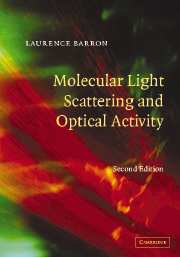Book contents
- Frontmatter
- Contents
- Preface to the first edition
- Preface to the second edition
- List of symbols
- 1 A historical review of optical activity phenomena
- 2 Molecules in electric and magnetic fields
- 3 Molecular scattering of polarized light
- 4 Symmetry and optical activity
- 5 Natural electronic optical activity
- 6 Magnetic electronic optical activity
- 7 Natural vibrational optical activity
- 8 Antisymmetric scattering and magnetic Raman optical activity
- References
- Index
2 - Molecules in electric and magnetic fields
Published online by Cambridge University Press: 07 August 2009
- Frontmatter
- Contents
- Preface to the first edition
- Preface to the second edition
- List of symbols
- 1 A historical review of optical activity phenomena
- 2 Molecules in electric and magnetic fields
- 3 Molecular scattering of polarized light
- 4 Symmetry and optical activity
- 5 Natural electronic optical activity
- 6 Magnetic electronic optical activity
- 7 Natural vibrational optical activity
- 8 Antisymmetric scattering and magnetic Raman optical activity
- References
- Index
Summary
Are not gross bodies and light convertible into one another; and may not bodies receive much of their activity from the particles of light which enter into their composition? The changing of bodies into light, and light into bodies, is very comformable to the course of Nature, which seems delighted with transmutations.
Isaac Newton (Opticks)Introduction
The theory of optical activity developed in this book is based on a semi-classical description of the interaction of light with molecules; that is, the molecules are treated as quantum mechanical objects perturbed by classical electromagnetic fields. Although quantum electrodynamics, in which the radiation field is also quantized, provides the most complete account to date of the radiation field and its interactions with molecules (Craig and Thirunamachandran, 1984), it is not used in this book since the required results can be obtained more directly with semiclassical methods.
The present chapter reviews those aspects of classical electrodynamics and quantum mechanical perturbation theory required for the semiclassical description of the scattering of polarized light by molecules. The methods are based on theories developed in the 1920s and 1930s when the new Schrödinger–Heisenberg formulation of quantum mechanics was applied to the interaction of light with atoms and molecules. Thus close parallels will be found with works such as Born's Optik (1933), Born and Huang's Dynamical Theory of Crystal Lattices (1954), Placzek's article on the theory of the Raman effect (1934) and also parts of the Course of Theoretical Physics by Landau and Lifshitz (1960, 1975, 1977), Lifshitz and Pitaevskii (1980) and Berestetskii, Lifshitz and Pitaevskii (1982).
- Type
- Chapter
- Information
- Molecular Light Scattering and Optical Activity , pp. 53 - 122Publisher: Cambridge University PressPrint publication year: 2004
- 1
- Cited by

